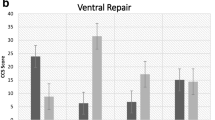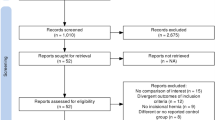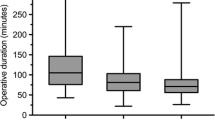Abstract
Purpose
The number of robot-assisted hernia repairs is increasing, but the potential benefits have not been well described. The aim of this study was to evaluate the available literature reporting on outcomes after robot-assisted hernia repairs.
Methods
This is a qualitative review and meta-analysis of papers evaluating short-term outcomes after inguinal or ventral robot-assisted hernia repair compared with either open or laparoscopic approach. The primary outcome was postoperative complications and secondary outcomes were duration of surgery, postoperative length of stay and financial costs.
Results
Fifteen studies were included. Postoperative complications were significantly decreased after robot-assisted inguinal hernia repair compared with open repair. There were no differences in complications between robot-assisted and laparoscopic inguinal hernia repair. For ventral hernia repair, sutured closure of the defect, retromuscular mesh placement and transversus abdominis release is feasible when using the robot. Length of stay was decreased by a mean of 3 days for robot-assisted repairs compared with open approach. There were no differences in postoperative complications and the operative time was significantly longer for robot-assisted ventral hernia repair compared with laparoscopic or open approach.
Conclusions
For ventral hernias that would normally require an open procedure, a robot-assisted repair may be a good option, as the use of a minimally invasive approach for these procedures decreases length of stay significantly. For inguinal hernias, the benefit of the robot is questionable. Randomized controlled trials and prospective studies are needed.





Similar content being viewed by others
References
Telem DA (2018) Is robotic surgery the future for abdominal wall hernia repair? Not so fast. Ann Surg 267(2):218–219. https://doi.org/10.1097/SLA.0000000000002336
Huang X, Wang L, Zheng X, Wang X (2017) Comparison of perioperative, functional, and oncologic outcomes between standard laparoscopic and robotic-assisted radical prostatectomy: a systemic review and meta-analysis. Surg Endosc 31(3):1045–1060. https://doi.org/10.1007/s00464-016-5125-1
Coakley KM, Sims SM, Prasad T, Lincourt AE, Augenstein VA, Sing RF, Heniford BT, Colavita PD (2017) A nationwide evaluation of robotic ventral hernia surgery. Am J Surg 214(6):1158–1163. https://doi.org/10.1016/j.amjsurg.2017.08.022
Bittner JG, Alrefai S, Vy M, Mabe M, Del Prado PAR, Clingempeel NL (2017) Comparative analysis of open and robotic transversus abdominis release for ventral hernia repair. Surg Endosc. https://doi.org/10.1007/s00464-017-5729-0
Sanchez A, Rodriguez O, Jara G, Sanchez R, Vegas L, Rosciano J, Estrada L (2018) Robot-assisted surgery and incisional hernia: a comparative study of ergonomics in a training model. J Robot Surg. https://doi.org/10.1007/s11701-017-0777-y
https://www.cebm.net/2009/06/oxford-centre-evidence-based-medicine-levels-evidence-march-2009/. Accessed 28 Aug 2018
Charles EJ, Mehaffey JH, Tache-Leon CA, Hallowell PT, Sawyer RG, Yang Z (2017) Inguinal hernia repair: is there a benefit to using the robot? Surg Endosc. https://doi.org/10.1007/s00464-017-5911-4
Kudsi OY, McCarty JC, Paluvoi N, Mabardy AS (2017) Transition from laparoscopic totally extraperitoneal inguinal hernia repair to robotic transabdominal preperitoneal inguinal hernia repair: a retrospective review of a single surgeon’s experience. World J Surg. https://doi.org/10.1007/s00268-017-3998-3
Tran H (2011) Robotic single-port hernia surgery. J Soc Laparoendosc Surg 15(3):309–314. https://doi.org/10.4293/108680811X13125733356198
Waite KE, Herman MA, Doyle PJ (2016) Comparison of robotic versus laparoscopic transabdominal preperitoneal (TAPP) inguinal hernia repair. J Robot Surg 10(3):239–244. https://doi.org/10.1007/s11701-016-0580-1
Kolachalam R, Dickens E, D’Amico L, Richardson C, Rabaza J, Gamagami R, Gonzalez A (2017) Early outcomes of robotic-assisted inguinal hernia repair in obese patients: a multi-institutional, retrospective study. Surg Endosc. https://doi.org/10.1007/s00464-017-5665-z
Bittner Iv JG, Cesnik LW, Kirwan T, Wolf L, Guo D (2018) Patient perceptions of acute pain and activity disruption following inguinal hernia repair: a propensity-matched comparison of robotic-assisted, laparoscopic, and open approaches. J Robot Surg. https://doi.org/10.1007/s11701-018-0790-9
Armijo P, Pratap A, Wang Y, Shostrom V, Oleynikov D (2017) Robotic ventral hernia repair is not superior to laparoscopic: a national database review. Surg Endosc. https://doi.org/10.1007/s00464-017-5872-7
Prabhu AS, Dickens EO, Copper CM, Mann JW, Yunis JP, Phillips S, Huang LC, Poulose BK, Rosen MJ (2017) Laparoscopic vs robotic intraperitoneal mesh repair for incisional hernia: an americas hernia society quality collaborative analysis. J Am Coll Surg. https://doi.org/10.1016/j.jamcollsurg.2017.04.011
Gonzalez AM, Romero RJ, Seetharamaiah R, Gallas M, Lamoureux J, Rabaza JR (2015) Laparoscopic ventral hernia repair with primary closure versus no primary closure of the defect: potential benefits of the robotic technology. Int J Med Robot 11(2):120–125. https://doi.org/10.1002/rcs.1605
Chen YJ, Huynh D, Nguyen S, Chin E, Divino C, Zhang L (2017) Outcomes of robot-assisted versus laparoscopic repair of small-sized ventral hernias. Surg Endosc 31(3):1275–1279. https://doi.org/10.1007/s00464-016-5106-4
Walker PA, May AC, Mo J, Cherla DV, Santillan MR, Kim S, Ryan H, Shah SK, Wilson EB, Tsuda S (2018) Multicenter review of robotic versus laparoscopic ventral hernia repair: is there a role for robotics? Surg Endosc 32(4):1901–1905. https://doi.org/10.1007/s00464-017-5882-5
Carbonell AM, Warren JA, Prabhu AS, Ballecer CD, Janczyk RJ, Herrera J, Huang LC, Phillips S, Rosen MJ, Poulose BK (2017) Reducing length of stay using a robotic-assisted approach for retromuscular ventral hernia repair: a comparative analysis from the Americas Hernia Society Quality Collaborative. Ann Surg. https://doi.org/10.1097/SLA.0000000000002244
Warren JA, Cobb WS, Ewing JA, Carbonell AM (2017) Standard laparoscopic versus robotic retromuscular ventral hernia repair. Surg Endosc 31(1):324–332. https://doi.org/10.1007/s00464-016-4975-x
Martin-Del-Campo LA, Weltz AS, Belyansky I, Novitsky YW (2018) Comparative analysis of perioperative outcomes of robotic versus open transversus abdominis release. Surg Endosc 32(2):840–845. https://doi.org/10.1007/s00464-017-5752-1
Tran H (2011) Safety and efficacy of single incision laparoscopic surgery for total extraperitoneal inguinal hernia repair. J Soc Laparoendosc Surg 15(1):47–52. https://doi.org/10.4293/108680811X13022985131174
Scheuermann U, Niebisch S, Lyros O, Jansen-Winkeln B, Gockel I (2017) Transabdominal preperitoneal (TAPP) versus Lichtenstein operation for primary inguinal hernia repair—a systematic review and meta-analysis of randomized controlled trials. BMC Surg 17(1):55. https://doi.org/10.1186/s12893-017-0253-7
Baker JJ, Oberg S, Andresen K, Klausen TW, Rosenberg J (2018) Systematic review and network meta-analysis of methods of mesh fixation during laparoscopic ventral hernia repair. Br J Surg 105(1):37–47. https://doi.org/10.1002/bjs.10720
Tandon A, Pathak S, Lyons NJ, Nunes QM, Daniels IR, Smart NJ (2016) Meta-analysis of closure of the fascial defect during laparoscopic incisional and ventral hernia repair. Br J Surg 103(12):1598–1607. https://doi.org/10.1002/bjs.10268
Belyansky I, Zahiri HR, Park A (2016) Laparoscopic transversus abdominis release, a novel minimally invasive approach to complex abdominal wall reconstruction. Surg Innov 23(2):134–141. https://doi.org/10.1177/1553350615618290
Turchetti G, Palla I, Pierotti F, Cuschieri A (2012) Economic evaluation of da Vinci-assisted robotic surgery: a systematic review. Surg Endosc 26(3):598–606. https://doi.org/10.1007/s00464-011-1936-2
Kudsi OY, McCarty JC, Paluvoi N, Mabardy AS (2017) Transition from laparoscopic totally extraperitoneal inguinal hernia repair to robotic transabdominal preperitoneal inguinal hernia repair: a retrospective review of a single surgeon’s experience. World J Surg 41(9):2251–2257. https://doi.org/10.1007/s00268-017-3998-3
Author information
Authors and Affiliations
Corresponding author
Ethics declarations
Conflict of interest
NAH and KKJ declare no conflicts of interest. FM declares conflict of interest not directly related to the submitted work; grants and personal fees from Medtronic and Dynamesh and personal fees from Intuitive Surgical, CMR Surgical and Bard Davol, no funding was received for the current work.
Ethical approval
Approval from the institutional review board was not required for this study.
Human and animal rights
This article does not contain any studies with human participants or animals performed by any of the authors.
Informed consent
For this retrospective review, formal consent is not required
Rights and permissions
About this article
Cite this article
Henriksen, N.A., Jensen, K.K. & Muysoms, F. Robot-assisted abdominal wall surgery: a systematic review of the literature and meta-analysis. Hernia 23, 17–27 (2019). https://doi.org/10.1007/s10029-018-1872-3
Received:
Accepted:
Published:
Issue Date:
DOI: https://doi.org/10.1007/s10029-018-1872-3




